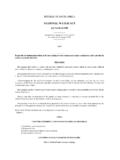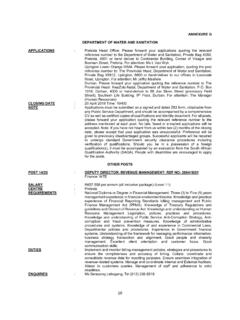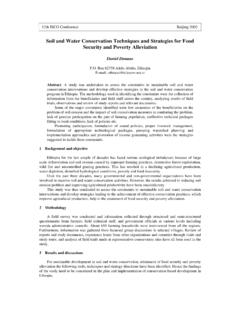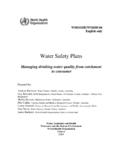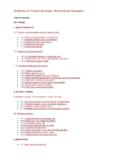Transcription of Guidelines for drinking-water quality - WHO
1 CONTENTSiWorld Health OrganizationGeneva1997 Guidelines fordrinking- water qualitySECOND EDITIONV olume 3 Surveillance and controlof community suppliesGUIDELINES FOR drinking - water QUALITYiiWHO Library Cataloguing in Publication DataGuidelines for drinking - water quality . 2nd : v. 3. Surveillance and control of community supplies1. drinking water standards 2. Data collection methods 3. Guidelines 4. Developingcountries I. Title: Surveillance and control of community suppliesISBN 92 4 154503 8 (v. 3) (NLM Classification: WA 657)The World Health Organization welcomes requests for permission to reproduce or translate its publica-tions, in part or in full. Applications and enquiries should be addressed to the Office of Publications, WorldHealth Organization, Geneva, Switzerland, which will be glad to provide the latest information on anychanges made to the text, plans for new editions, and reprints and translations already available.
2 World Health Organization 1997 Publications of the World Health Organization enjoy copyright protection in accordance with the provi-sions of Protocol 2 of the Universal Copyright Convention. All rights designations employed and the presentation of the material in this publication do not imply theexpression of any opinion whatsoever on the part of the Secretariat of the World Health Organizationconcerning the legal status of any country, territory, city or area or of its authorities, or concerning thedelimitation of its frontiers or mention of specific companies or of certain manufacturers products does not imply that they areendorsed or recommended by the World Health Organization in preference to others of a similar naturethat are not mentioned.
3 Errors and omissions excepted, the names of proprietary products are distin-guished by initial capital IN HONG KONGPRINTED IN MALTA96/11027 Best-set/Interprint 8000 CONTENTSiiiPrefaceixAcknowledgementsxiAc ronyms and abbreviations used in the textxii1. Scope and Community water Health water water -washed Objectives of surveillance and quality Organizational The surveillance quality control and the role of the Community Role of surveillance in improvement of water supplies152. Planning and implementation of Legal and institutional Laws, regulations, and Institutional framework for General Designing Training28 ContentsGUIDELINES FOR drinking - water Preliminary Undertaking Establishing routine Information Flow and use of Information exchange with Information exchange within the Information exchange with Communication with local and Communication linkage between surveillanceand remedial Use of Support Laboratory Financial Staffing413.
4 Nature and scope of community Sanitary Sanitary inspection Functions of sanitary inspection report Design of sanitary inspection report Carrying out sanitary Timing and frequency of sanitary New Routine surveys of existing supplies484. water sampling and Location of sampling Sampling Sampling methods for Storage of samples for Sampling methods for Bacteriological Indicator Principal analytical Choice of Minimizing the cost of Laboratory-based versus on-site Single-application (disposable) test Physicochemical Chlorine Aesthetic Taste and Other analyses of relevance to Analytical quality assurance and quality Safety725. Data analysis and Results of community Evaluation of water -supply Hygiene Assessment of the sanitary Microbiological water Risk Presentation of Target Simple data Use of surveillance Use of data at local Regional use of Use of data for national planning836.
5 Technical Prevention and remedial Protecting water sources85 Guidelines FOR drinking - water catchment Groundwater Dug Hand-pumped and mechanically Rainwater water Preliminary treatment by Plain Slow sand Coagulation, flocculation, and Rapid sand Fluoride Control of nitrites and water -treatment Household water treatment and Household water Household water Storage tanks1277. Hygiene Scope of hygiene Community-based Hygiene Planning hygiene Community participation and Selection of behaviours to be Factors influencing hygiene behaviour andselection of content of Selection of target Information needs for hygiene Educational Human resources for hygiene Role of the surveillance agency in hygiene Funding hygiene education activities139 CONTENTSvii8.
6 Legislative, regulatory, policy, and basicmanagement Application of water -supply Short- and medium-term Compliance: the role of the water -supplyagency and the surveillance Surveillance Sampling frequencies and Prescribed analytical Technical regulations: construction, operation, andplumbing codes of practice144 Selected further reading145 Annex 1. List of contributors and reviewers147 Annex 2. Examples of sanitary inspection forms150 Annex 3. Examples of possible responsibilities ofsurveillance staff178 Annex 4. Sampling methods for bacteriological testing182 Annex 5. Multiple-tube method for thermotolerant (faecal)coliforms189 Annex 6. Membrane filtration method for thermotolerant(faecal) coliforms212 Annex 7. Field test method for thermotolerant (faecal)coliforms219 Annex 8.
7 Presence absence test for total coliform bacteria224 Annex 9. Residual free chlorine test226 Annex 10. Turbidity and pH231 Annex 11. Examples of regional and national monitoringreport forms for water supplies and for coveragewith basic sanitary facilities234 Guidelines FOR drinking - water quality viiiCONTENTSixPrefaceThe first edition of Guidelines for drinking - water quality was published by WHOin 1984 1985 and was intended to supersede earlier European and internationalstandards. Volume 1 contained guideline values for various constituents of drink-ing- water and Volume 2 the criteria monographs prepared for each substance orcontaminant on which the guideline values were based; Volume 3 was concernedwith the monitoring of drinking - water quality in small communities, particularlythose in rural the International drinking - water Supply and Sanitation Decade(1981 1990) considerable experience was gained in the surveillance and im-provement of small-community supplies, notably through a series of demonstra-tion projects supported by WHO.
8 This new edition of Volume 3 of Guidelines fordrinking- water quality reflects the experience of these and many other projectsconcerned with improving the quality of water services undertaken during number of important principles were established in the first edition ofVolume 3 of the Guidelines and these continue to form an important part of thesecond edition. They include the distinct and complementary roles of the watersupplier and the surveillance agency; the unique nature of the problems associatedwith monitoring small-community supplies (especially in developing countries);the central role of the microbiological monitoring of supplies of this type; and theimportance of ensuring that surveillance leads to engineering improvements andother remedial measures.
9 Experience gained during the Decade has highlightedthe importance of other fundamental concepts which have been incorporatedinto this new edition, including the need to consider not only drinking -waterquality, but also all aspects of water -supply services that influence health, and toaddress the problems of small periurban areas not covered by such conditions vary from country to country as a result of differences ineconomic, geographical, cultural and social conditions, the strategies and proce-dures described here should nevertheless be widely applicable. Thus it is hopedthat this Volume, like the first edition, will prove useful to all those concernedwith drinking - water supply to small communities: environmental health inspec-tors, sanitary technicians, laboratory personnel, water engineers, planners and allthose in the health and water -supply sector with managerial responsibility forGUIDELINES FOR drinking - water quality ximproving water -supply services to communities.
10 For the purposes of this publi-cation, the term communities applies not only to villages and small privatewater supplies in rural areas but also to other centres of population within, or inclose proximity to, urban preparation of this volume was begun at a Review Meeting on Surveillanceof Community Supplies, held in Harare, Zimbabwe, on 24 28 June 1991, whena detailed outline was agreed. The first draft of Volume 3 was reviewed at theFinal Task Group Meeting on the Revision of the WHO Guidelines for drinking - water quality , held in Geneva on 21 25 September 1992, and a revised draft wassubsequently finalized at a Meeting on Technical Revision of Volume 3, held inTirana, Albania, on 15 20 June 1993. The final version is the outcome of thework of a number of contributors and reviewers whose names are given in Annex1; their assistance is greatly appreciated.










